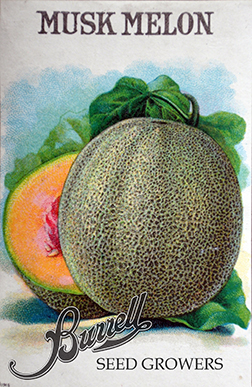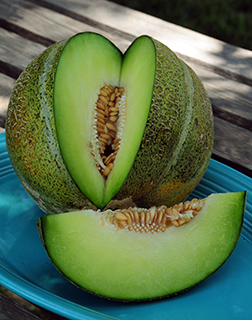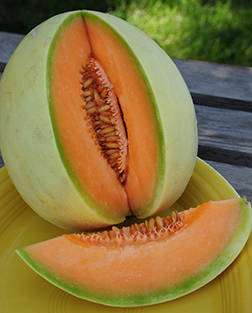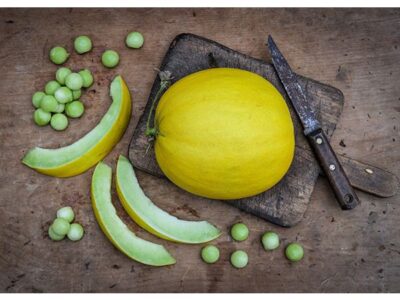Growing Melons.
Melons are the perfect, portable, party food. Tuck it under your arm and go. You will be the hit of the barbecue with our specialty melons. Each variety has unique flavor and testing melons in our seed fields is a real hardship, but someone has to do it! Grow several kinds; early, midseason and late maturing melons. There may be more than one picnic to attend.
Honeydew, Casaba, Crenshaw, Canary, Ogen and Persian melon seeds may be planted directly in the ground when soil temperature reaches 65º and all danger of frost is past. Heavy feeders, they prefer a sandy loam amended with composted manure. In cooler climates, start seedlings inside, transplanting when putting out the rest of your warm weather crops. Planting in hills, 3′ apart in rows 5′ or 6′ apart is recommended. Seed should be planted at a 1″ depth. water at the base of the plant or with irrigation every two weeks until melons reach softball size. Drier soil at this stage improves sugar content. Unlike cantaloupes, honeydews do not slip of the vine. They need to be cut with a sharp knife. They are ripe when the skin is creamy white and waxy. You can actually see microscopic hairs on a ripe honeydew.
Honeydews are vulnerable to cucumber beetles. We sparingly spray with pyrethrum in our fields, as our bees are vital to our operation. At home, you can vacuum the striped cucumber beetles off the vines. Empty the vacuum into soapy water to kill them.
Good companion crops are nasturtium, catnip, radish, marigolds and mints. A bad companion crop is potatoes.
-

Honeydew – Sweet Delight
$2.60 – $32.10 -

Melon – Schoon’s Hard-Shell
$2.60 – $22.40 -

Melon – Yellow Canary
$2.60 – $31.20 -

Melon – Ogen (Ha’Ogen)
$2.60 – $44.60 -

Melon – Crenshaw
$2.60 – $54.10 -

Melon – Casaba Golden Beauty
$2.60 – $54.10 -

Honeydew – Orange Flesh
$2.60 – $54.10 -

Honeydew – Green Meated
$2.60 – $30.10 -

Honeydew – Golden Honeymoon (Gold Rind Honeymoon)
$2.60 – $28.10 -

Melon – Sapomiel F1
$6.10 – $107.00
Growing Melons
Plant 2 lb. per acre in drills or 1 lb. if hand planted in hills 1 oz. to 100 hills. Plant 1 inch deep. The land should be sandy loam, avoiding both to sandy and too heavy soil. If possible, do not plant where melons were grown previously within three or four years. A heavy stubble plowed under is one of the first locations. Bean land is usually very good. The first year after alfalfa or clover is not good as a rule because the melons grow to soft and are irregular in size, shape, nettings and quality. The second year after alfalfa or clover is usually very good. Fall plowing is best, followed in the spring with several discing. If planted in hills the rows should be 5 to 6 feet apart each way. Cross cultivating improves the yield, quality and earliness. Plant ten to twelve seeds to the hill about 2 inches deep and thin to one or two plants when they have 5 or 6 leaves. Melon seed needs to have a minimum of at least 60 degrees Fahrenheit within the top 4 inches of soil to have a good germination. If drilled in rows 5 to 6 feet apart thin to one plant every 3 to 4 feet. Hoe carefully around the plants; keep free from weeds and cultivate often. We have found 8 or 10 cultivations at least should be giving and more would be better. After the vines reach so far across the row that you can no longer cultivate, the ends of the vines should be carefully turned back and an additional cultivation given. Cultivate shallow close to the plants and deeper farther away. Deep cultivation will cut the roots and damage the crop. The main spread of roots is on the harder ground under the plowed ground. For this reason plowing should be 8″-10″ deep and cultivation by knives or sweeps rather than shovels. If under irrigation, cantaloupes should be watered regularly about every two weeks. Early in the season furrows should be close to the plants and water should be allowed to run just long enough to moisten the soil beyond the plant row. Later furrows may be kept farther away from the plants. Do not allow the water to remain in the furrows to long so that the soil becomes waterlogged. Continue irrigating through the ripening season to keep the vines thrifty. Do not water after fruit reach softball size to allow the fruit to develop proper flavor and sweetness. Adequate bee population is necessary for good pollination and fruit set.
-

Honeydew – Sweet Delight
$2.60 – $32.10 -

Melon – Schoon’s Hard-Shell
$2.60 – $22.40 -

Melon – Yellow Canary
$2.60 – $31.20 -

Melon – Ogen (Ha’Ogen)
$2.60 – $44.60 -

Melon – Crenshaw
$2.60 – $54.10 -

Melon – Casaba Golden Beauty
$2.60 – $54.10 -

Honeydew – Orange Flesh
$2.60 – $54.10 -

Honeydew – Green Meated
$2.60 – $30.10 -

Honeydew – Golden Honeymoon (Gold Rind Honeymoon)
$2.60 – $28.10 -

Melon – Sapomiel F1
$6.10 – $107.00
Growing Melons.
Melons are the perfect, portable, party food. Tuck it under your arm and go. You will be the hit of the barbecue with our specialty melons. Each variety has unique flavor and testing melons in our seed fields is a real hardship, but someone has to do it! Grow several kinds; early, midseason and late maturing melons. There may be more than one picnic to attend.
Honeydew, Casaba, Crenshaw, Canary, Ogen and Persian melon seeds may be planted directly in the ground when soil temperature reaches 65º and all danger of frost is past. Heavy feeders, they prefer a sandy loam amended with composted manure. In cooler climates, start seedlings inside, transplanting when putting out the rest of your warm weather crops. Planting in hills, 3′ apart in rows 5′ or 6′ apart is recommended. Seed should be planted at a 1″ depth. water at the base of the plant or with irrigation every two weeks until melons reach softball size. Drier soil at this stage improves sugar content. Unlike cantaloupes, honeydews do not slip of the vine. They need to be cut with a sharp knife. They are ripe when the skin is creamy white and waxy. You can actually see microscopic hairs on a ripe honeydew.
Honeydews are vulnerable to cucumber beetles. We sparingly spray with pyrethrum in our fields, as our bees are vital to our operation. At home, you can vacuum the striped cucumber beetles off the vines. Empty the vacuum into soapy water to kill them.
Good companion crops are nasturtium, catnip, radish, marigolds and mints. A bad companion crop is potatoes.

